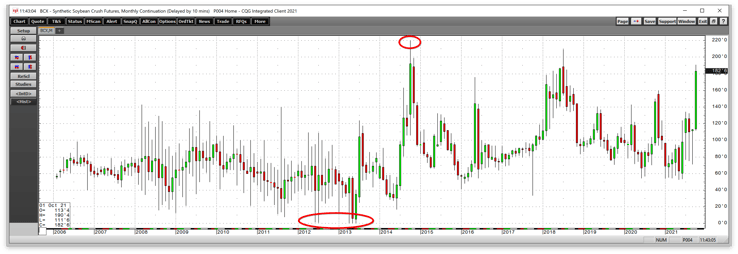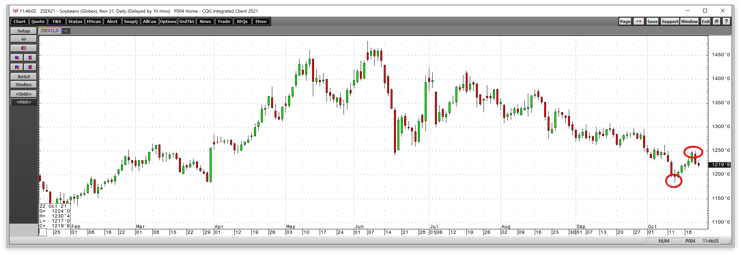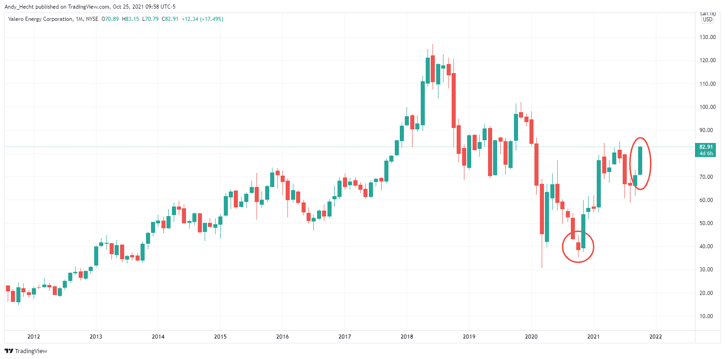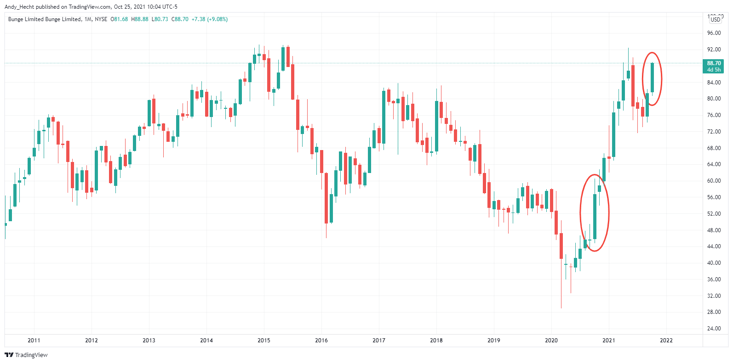October 25, 2021
Processing Spreads Provide Fundamental Clues
By Andrew Hecht
- Market structures are the pieces of a jigsaw puzzle
- Processing spreads are real-time supply and demand barometers
- The soybean crush spread
- Gasoline and distillate crack spreads
- Monitoring corporate profits
Some futures markets offer contracts that are related to others and are processed products of the commodity. Understanding the price relationships, history, and paths of least resistance of the processed product versus the original input can provide valuable insight into supply and demand fundamentals. Moreover, these relationships shed light on other related assets.
There is so much data at our fingertips, but we need to understand how to use and interpret the information. Processing spreads are invaluable tools as they are critical variables for market calculus when forecasting the path of least resistance of prices.
The crude oil and soybean futures markets offer liquid futures contracts in products that can reveal significant trends, warning signs, and calls to action. Anyone who undertakes a home improvement project knows that the job will not go well without the correct tools. Trying to hammer in a nail with a screwdriver is far from optimal. Tightening a bolt with an ax is a disaster. The best tool leads to the optimal result. The processing spread is one of the most critical tools in my investment and trading toolbox.
Market structure are the pieces of a jigsaw puzzle
In the world of commodities, market structure are integral pieces of a puzzle. When put together, they provide clues about the path of least resistance of prices as they reflect and can be real-time indicators of supply and demand fundamentals. A commodity’s market structure includes:
- Term structure- Price differentials for nearby versus deferred delivery periods.
- Location differentials- Price differentials for delivery of a raw material in different regions.
- Quality differentials- Price differentials for differing grades, sizes, or composition of the same commodity.
- Substitution spreads- The price comparison of one commodity for another that can serve as a substitute.
- Processing spreads- The margin or differential for refining or transforming one commodity into its products.
Together, the various pieces that comprise a market’s structure create a picture that often points to higher or lower price paths.
Processing spreads are real-time supply and demand barometers
The processing spread is one of the valuable tools in an analysts’ toolbox. It tells us if demand for the products is rising or falling.
Consumers often require the processed product instead of the raw commodity. The differential between prices of the input, the commodity, and the output, the product, is a critical fundamental measure. Narrowing processing spreads signal falling demand while widening spreads are a sign that supplies are not keeping pace with requirements. Since futures contracts prices are constantly changing, processing spreads can be volatile. When the commodity and product trade in the futures market, the differentials provide a unique supply and demand perspective for traders and investors. There can be many reasons for price variance in processing spreads. However, comparing them to historical levels can serve as real-time indicators of fundamental forces that determine the underlying commodity’s price direction when exogenous factors are not impacting the overall refining or treatment process.
Many commodities do not offer futures contracts in the products. The soybean and crude oil markets are exceptions.
The soybean crush spread
Soybean futures trade on the CME’s CBOT division. Soybean products, soybean meal, and soybean oil also trade in the futures markets on the CBOT with separate and independent futures contracts. Soybean meal is a critical ingredient in animal feed, while soybean oil is cooking oil. Both have other uses.
Processors crush raw soybeans into the two products; the oil is the liquid from the crushing process, while the meal is the solid substance.
The soybean crush spread can be highly volatile.

Source: CQG
The monthly chart shows the soybean crush spread over the past fifteen years. The spread traded to a low of a quarter of one cent to as high as $2.1950. The low was in 2013 when soybean futures were trending lower from the all-time high in 2012 at $17.9475 per bushel. The high was in October 2014 when soybean futures were consolidating at lower levels. The move to the high was because consumers bought soybean products at lower prices around the $10 per bushel level.
More recently, the crush spread signaled that soybean futures had run out of downside steam. After trading to a high of $16.7725 per bushel in May 2021, the oilseed futures fell below $12 in October. When soybeans were on the high in May, the crush fell to a low of 52.75 cents.
 Source: CQG
Source: CQG
At high soybean prices, consumers backed off buying the oilseed products, leading to a price correction that took the price below the $12 per bushel level in October. Meanwhile, falling prices caused demand for products to return. The crush spreads traded to the most recent high at $1.9050 during the week of October 18. The rising crush spread was a sign of robust demand that lifted the raw soybean futures from the recent low.
 Source: CQG
Source: CQG
The November soybean futures chart shows the rise from a low of $11.8450 to the $12.50 level. The price action in the crush spread was a signal that demand for products would lift the soybean futures price. The processing spread action signaled the price bottom over the past weeks.
Gasoline and distillate crack spreads
Crude oil refiners process the raw energy commodity that powers the world into products, gasoline, and distillates. The NYMEX futures market trades contracts in crude oil, gasoline, and heating oil. Heating oil is a distillate fuel that is a proxy for other distillates, including jet and diesel fuels. Refineries process crude oil into the oil products by heating them to different temperatures in a catalytic cracker. The price differential between the input, crude oil, and the output, the products, are “crack spreads.” Rising crack spreads point to increasing demand for oil products. When they fall, it is a sign of oversupply or weak demand.
Crude oil futures reached lows in April 2020 during the height of the global pandemic’s impact on markets across all asset classes.
 Source: CQG
Source: CQG
The NYMEX crude oil futures weekly chart highlights the bullish trend since April 2020 as the energy commodity has made higher lows and higher highs.
 Source: CQG
Source: CQG
The weekly chart of the gasoline crack spreads highlights the bullish trend since March 2020. Gasoline is a seasonal commodity that tends to reach highs during the spring and summer months and decline during the winter as drivers tend to put more mileage on their cars during the warm months. However, at the $17.63 per barrel level at the end of last week, the gasoline crack spread was appreciable higher than the peak in October 2020, when it reached $11.62 per barrel. The gasoline crack spread has provided bullish validation for the path of least resistance of crude oil’s price.
 Source: CQG
Source: CQG
The weekly heating oil or distillate crack spread chart also displays a bullish trend. Distillates tend to be less seasonal than gasoline as jet and diesel requirements are year-round. At the $22.53 per barrel level at the end of last week, the heating oil crack was far higher than its October 2020 peak at $9.96 per barrel.
The crack spreads have supported the rising crude oil price as they point to robust product demand.
Monitoring corporate profits
While processing spreads can provide insight into the path of least resistance of prices for commodities that are inputs, they are also real-time earnings indicators for companies that refine or process the raw commodities into the products.
Refiners or processors tend to buy the input at market prices and sell products at market prices. The refiners and processors make significant capital investments in refineries or other processing equipment. They make or lose money on the processing spread. When they widen, they experience a profit bonanza; when they fall, times can get rough. When the spreads rise above the cost of the process, profits rise. Low processing spread levels can lead to losses.
Valero (VLO) is a company that refines crude oil into oil products.
 Source: TradingView
Source: TradingView
The chart shows that the high in October 2020 was at $44.88 per share. In October 2021, VLO was over the $80 level at the end of last week. Rising crack spreads have lifted profits for the oil refiner.
Archer Daniel Midland (ADM) and Bunge Ltd. (BG) are leading agricultural processors. Soybean processing is one of the many business lines for the two companies. The rising soybean crush spreads have lifted profits for the companies.
 Source: TradingView
Source: TradingView
In October 2020, ADM shares reached a high of $52.05 per share. At the end of last week, the stock was at the $66.22 level.
 Source: TradingView
Source: TradingView
BG shares reached a high of $60.50 in October 2020 and were trading at the $88.33 level at the end of last week. The rise soybean crush spreads at least partially supported rising profits and higher share prices for ADM and BG.
Processing spreads are real-time indicators for the demand of the commodities that are the inputs. They are also real-time earnings barometers for companies that process commodities into products. Any tool that improves your ability to analyze markets is worth keeping in that toolbelt.
Trading advice given in this communication, if any, is based on information taken from trades and statistical services and other sources that we believe are reliable. The author does not guarantee that such information is accurate or complete and it should not be relied upon as such. Trading advice reflects the author’s good faith judgment at a specific time and is subject to change without notice. There is no guarantee that the advice the author provides will result in profitable trades. There is risk of loss in all futures and options trading. Any investment involves substantial risks, including, but not limited to, pricing volatility, inadequate liquidity, and the potential complete loss of principal. This article does not in any way constitute an offer or solicitation of an offer to buy or sell any investment, security, or commodity discussed herein, or any security in any jurisdiction in which such an offer would be unlawful under the securities laws of such jurisdiction.
